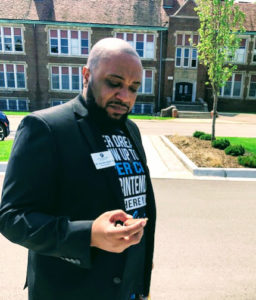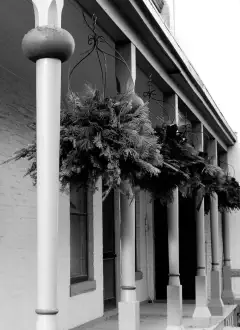By Jan Worth-Nelson
After the joyful ribbon-cutting ceremony for the Flint Public Library Thursday, Flint Community Schools Superintendent Kevelin Jones slipped away alone across the parking lot from the glossy new building to the empty wreck that is the former Flint Central High School, closed in 2009 and now crumbling, tagged, vandalized and boarded up just a few dozen yards away.
The contrast could not have been more pointed.

Flint Community Schools Superintendent Kevelin Jones holding a brick from Flint Central High School (in background) just a few dozen yards from the Flint Public Library (Photo by Jan Worth-Nelson)
“Today was emotional,” Jones said. “As I walked through the library and I looked over at Flint Central, well, I took the walk on purpose, I took the walk because I’m imagining our scholars being able to take that walk.”
Jones picked up a piece of brick fallen from the vacant high school, which stands starkly abandoned and far removed from its one-time bustling and vigorous life at the hub of Flint’s public education. Several proposals for its disposition have been floated, none acted upon.
For Jones, who grew up in Flint and attended Flint public schools all the way through, the grand re-opening of the $30 million library — its hundreds of cubic yards of windows, people-friendly new furniture, renovated infrastructure systems from the ground up — came with an intense vein of exasperation and sadness for his beleaguered district.
“I took a piece of the brick,” he said, wiping his eyes. “This brick is going to be on my desk to remind me that this is my job. I’m sorry for my tears,” he said, while gathering his thoughts.
“This brick is a reminder of what I’m supposed to do.”.
In his remarks under the tent at the ribbon cutting, Jones congratulated the library for its accomplishments, and then said, referring to his beleaguered public schools, “We got next.”
The public library has been able to remake itself, with $16 million in support from the C.S. Mott Foundation and other major donors, along with another $12 million from a bond approved by 68 percent of voters in 2019.
But the Flint School District has floundered, enrollment down to barely 3,000 students and its buildings in increasingly dire disrepair. The Flint Board of Education has so far declined to act on a $200 million “Memo of Understanding” offered by the Mott Foundation to build new schools, a plan detailed in 2021 by EVM education reporter Harold Ford.
Even with $32 million in federal COVID funds landing in its coffers, the FCS faces serious financial problems. Without the one-time COVID boost, the district faces a $21.5 million annual deficit, according to FCS officials.
But the FCS board has struggled to come up with a plan to cover the deficit or deal with what experts both internal and outside, have termed urgent needs for infastructure repair.
“I’m encouraged today to keep fighting,” Jones said, cupping the Flint Central brick in his right hand. ” I’m gonna fight for our scholars to have new schools, to have the best education possible, and to ensure that the time I spend in the FCS is going to be spent doing that.
“Our scholars need to be able to take this walk. They need to be able to look back and say, that is my school. Right now, they can’t say that. With all this greatness around us, we need to be a part of it.
“The Mott Foundation has been adamant about a relationship with the Flint Community Schools,” Jones noted, despite the board’s reluctance to move forward on the proposed partnership, tabbed the Flint Education Continuum.
In June of 2021, Mott Foundation President and CEO Ridgway White appeared before the board to plead for consideration of the partnership, but a majority of board members have not only resisted the plan, but declined even to put it on the agenda for discussion.
“So, we have to have votes from the board for that to happen. I am pleading with our board to have the conversations necessary to get this done. I know we can get it done.”
Jones’s own son is in fifth grade at Doyle Ryder Elementary, a building closed and the students moved to another school in August, 2021, because of a black mold infestation. Jones said he almost took his son out of the district, but his son protested because he loved his teachers and wanted to be with his friends.
“Our scholars know nothing of politics. What they know about is where they are currently learning. Kids are about creativity and opportunity to learn, and it’s the people that they love. But some of our buildings they don’t have air conditioning — there are so many problems.”
As summarized in numerous EVM articles over the years, the district’s 11 school buildings average 70 years old, with infrastructure problems including “HVAC (heating, ventilation, air conditioning) systems; electrical grids unable to support HVAC systems; yet-to-be-installed hydration stations or smart water fountains; unreliable internet capabilities; outdated plumbing; crumbling athletic facilities; leaky roofs,” according to a 2021 EVM education reporter Harold Ford overview.
When the black mold led to teachers walking out of Doyle Ryder and the students moved out during a $400,000 cleanup, Jones said his son poignantly asked, “Dad, are we going to get new buildings?
And I said, ‘Son, yes, we are, but it’s going to take some time.’ ‘
“And so I took this walk to remind myself of why I’m here. It’s time for me to pick the bricks up,” he said.

EVM Consulting Editor Jan Worth-Nelson can be reached at janworth1118@gmail.com.


You must be logged in to post a comment.